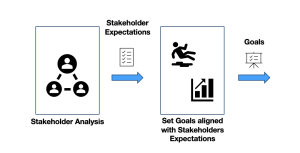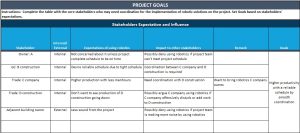2 Set Goals
Objective: Implementing robotics in construction projects necessitates specific, clearly outlined goals that align with the desires and anticipations of project stakeholders. Understanding the stakeholders’ identities, impact, and project expectations would enhance the situation. From these, the project team can set common Goals that they want to achieve through robotics implementation. (see Figure 2-1)

Figure 2.1. Process of Set Goals
Aligning Project Goals with Stakeholder Expectations:
It entails carefully identifying the stakeholders who are most likely to be engaged in a project and evaluating their power, influence, and interests as they may impact its conclusion results. The project team will be able to set goals that will satisfy their needs and expectations, which are essential for the project’s success.
By understanding stakeholder interests and priorities, project teams can establish specific goals, ensuring that robotic adoption aligns with stakeholders’ project success vision. Setting clear goals ensures deliverables align precisely with stakeholder expectations. This helps avoid project scope expansion, improves communication, preemptively resolves conflicts, and supports smoother, sustainable project execution. Sample project goals are shown in Table 2-1. In addition, a blank Set Goals worksheet can be found in Appendix A. Other typical examples of Stakeholders and their expectations, and Goals are listed below.
Table 2.1. Set Goals Sample

Example of Key Stakeholders and Their Expectations:
- Owner: The owner focuses on budget, timeline, quality, appearance, marketing, and safety. The owner holds the final decision-making power and risks associated with the profitability of robotics implementation. However, the owner is not fully involved in the planning and implementation stage. Influence is middle. An example of the owner’s expectation is a contractor demonstrating a return on investment through cost savings and enhanced safety.
- Project Management: PM concerns budget, timeline, profit, and safety. The complexity of robotics could impact the contractor’s ability to meet deadlines and budget constraints. Influence is high. An example of the PM’s expectation is higher productivity with a smooth integration of robotics that does not disrupt the overall project flow.
- Trade Using Robotics: Trade using robotics focuses on job ease, productivity, skill retention, and recognition. Their implementation needs support from and coordination with PM and other trades. Influence is high. An example of their expectation is higher productivity to meet the schedule with ease of operation.
- Trades not Using Robotics: These trades could be affected by other trades using robotics. Their support or resistance can significantly influence the success of robotic adoption. Influence is high. An example expectation is to minimize the effects on their work from robotic utilization at the site.
Examples of Goals:
- Safety-Focused Goals: Implement robotics for high-risk tasks to reduce the potential for worker injuries.
- Productivity and Efficiency Goals: Integrate robots to streamline repetitive tasks such as material handling and site inspections, reducing project timelines.
- Quality Improvement Goals: Utilize advanced robotic systems to maintain consistent, high-quality results across repetitive processes.

